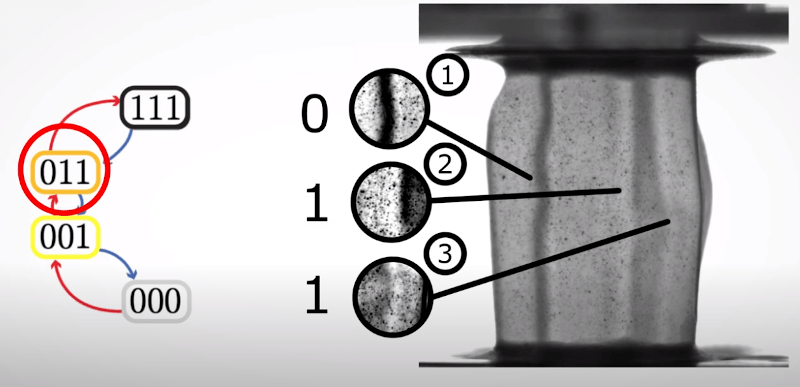If you ever get a chance to go to Leiden, take it. It is a beautiful little city that hides some high-power university research. It also boasts the world’s first rubber computer. You won’t be running Crysis on it anytime soon, though. The fledgling computer has memory and can count to two — really more of a state machine. It is easier to watch the video below than try to fully explain it. Or you can read through the actual paper.
If you watch the video, you’ll see that deformation in the corrugated rubber structure is apparently repeatable and represent bits in the machine. Pressing and releasing pressure on the structure forms both input and clock and it is possible for the material to go from state A to B on compression, but when you release pressure, it reaches state C. The compression and the angle of the pressure allow for different input conditions. One example rubber state machine counts how many times you compress the piece of rubber.
What do you do with a piece of smart rubber? We don’t know. Maybe if you wanted shoes to count steps so you could transmit the count once a minute to save on battery? The researchers have admitted they don’t have any specific applications in mind either, but presume someone will want to use their work.
Of course, the video’s title: “The Rubber Computer” is a bit of hyperbole, but we can forgive it. Most people wouldn’t get “The Rubber Finite State Machine.” While mechanical computing might seem a bit passe, turns out at the molecular level it may become very important. Besides, you can make a computer out of cardboard (or simulate that computer in an FPGA or spreadsheet, if you prefer).
















Is it Oring complete ?
If so, we could use it as the ECU on a turing car
Bluetooth tracking condoms before you know it……
Maybe something like this could be useful on a fully mechanical Venus rover, with a rubber-like material that can survive those temperatures.
It would wiser to find a semiconductor that becomes a semiconductor at higher Venusian temperature ranges or can simply withstand the temperature. A mechanical system like this isn’t going to be fast enough to do anything of interest. MEMS-based computing would be a better choice long before this.
What’s wrong with core memory? It got us on the moon and back, even without a 555.
Is it tyring complete?
Good God, man. At the very least spell the man’s name correctly.
You didn’t get the joke. No need to cuss.
Cuss?? lol
I suspect it was an attempted pun. Rather than “Turing”, “tire”-ing, probably with the British spelling “tyre”-ing.
As is so often the case, the humor of a joke is inversely proportional to how much you have to explain it.
:-)
Yea.. But it’s British, so it does not translate to other languages
Cap
Whoosh
Not a good year for you, man…
tehehehe
This computer actually works better if you bash it repeatedly with a baseball bat.
I could imagine something like this as a layer of skin for counting pressure, but I can’t see its current dimensions. You’d have to electrify it to relay some signals.
I’m calling bullshit. You have to tilt this piece of rubber so you can apply pressure on different parts. I can tie knots in a bit of string and get better memory storage than this. Then I can untie them and call it computing. An abacus is more of a computer than this. There’s no way to measure the memory without using your eyes or a camera to look at it. Who does all the processing of the stored information? Human brains or REAL computers connected to the camera taking the pictures. This is a non-discovery, convoluted explanation of a manual task pretending to be something it isn’t. Of all the interesting articles on phys.org, you picked the worst.
smart rubber? :D anyone else thinking of the 2011 trash movie “rubber” (a telekinetic rubber tire rolls around and kills people) https://www.youtube.com/watch?v=XWWufhqyGE8 (trailer)